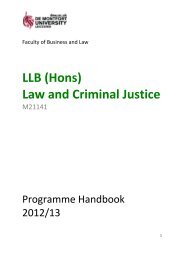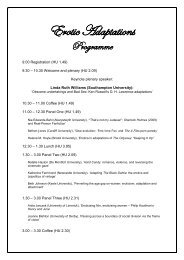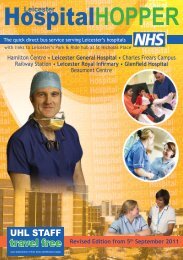Evaluation of the Crash Course March 2009 - De Montfort University
Evaluation of the Crash Course March 2009 - De Montfort University
Evaluation of the Crash Course March 2009 - De Montfort University
Create successful ePaper yourself
Turn your PDF publications into a flip-book with our unique Google optimized e-Paper software.
This may show itself in <strong>the</strong> <strong>Crash</strong> <strong>Course</strong> situation. If personal testimony is<br />
important, that will be a particular success factor and it would probably only work<br />
under certain circumstances, such as having contributors with <strong>the</strong> right sort <strong>of</strong><br />
experience or speakers being able to control <strong>the</strong>ir emotions.<br />
In <strong>the</strong> view <strong>of</strong> <strong>the</strong> research team, <strong>the</strong> ‘mechanism’ making <strong>the</strong> <strong>Crash</strong> <strong>Course</strong><br />
effective is <strong>the</strong> use <strong>of</strong> a combination <strong>of</strong> facts, visual images and emotion in face to<br />
face delivery by a team <strong>of</strong> credible people with direct experience <strong>of</strong> <strong>the</strong> effects <strong>of</strong><br />
road collisions. The team requires factual knowledge, stark images and a variety <strong>of</strong><br />
first-hand experience. Team members have to be able to show appropriate feelings<br />
but also to control <strong>the</strong>ir emotions. They need to be able to engage a youth audience<br />
and control anger about inappropriate responses. They need a context <strong>of</strong> pastoral<br />
support for <strong>the</strong>mselves as well as for <strong>the</strong> young participants. They need stable<br />
supportive management and <strong>the</strong> vigorous backing <strong>of</strong> a multi-agency partnership. The<br />
<strong>Crash</strong> <strong>Course</strong> also needs to adhere to <strong>the</strong> principles shown from research about <strong>the</strong><br />
circumstances that make fear-based messages effective in risk reduction.<br />
The core content file <strong>of</strong> <strong>the</strong> <strong>Crash</strong> <strong>Course</strong> should be revisited and updated. It is<br />
possible that team members could become too familiar with <strong>the</strong> material with long<br />
practice and <strong>the</strong> essence <strong>of</strong> <strong>the</strong> educational messages and methods needs to be<br />
captured for future transfer elsewhere. Thereafter copyright should be taken on this<br />
effective pattern <strong>of</strong> intervention so that <strong>the</strong> essential mechanism can be preserved<br />
and replicated. Fidelity is a major issue for successful social interventions. While <strong>the</strong><br />
<strong>Crash</strong> <strong>Course</strong> content remains an informal arrangement, <strong>the</strong>re is a danger <strong>of</strong><br />
attempts to replicate it without some <strong>of</strong> its essential ingredients.<br />
It is tempting to think that <strong>the</strong> <strong>Crash</strong> <strong>Course</strong> could only be successful with <strong>the</strong><br />
personalities <strong>of</strong> <strong>the</strong> present team involved. These individuals are undoubtedly<br />
talented and committed but <strong>the</strong>re is no evidence in this study to suggest that <strong>the</strong>y are<br />
irreplaceable or that <strong>the</strong> basic mechanism could not be transferred elsewhere. It is<br />
essential that new personnel are recruited to <strong>the</strong> team as a matter <strong>of</strong> priority. Failing<br />
that this effective intervention is certain to die out in time and its coverage will be<br />
necessarily limited. There is no spare capacity within <strong>the</strong> current team strength to<br />
deliver more and demands are increasing for fur<strong>the</strong>r presentations to adults.<br />
The responses <strong>of</strong> adult stakeholders and <strong>the</strong> young people <strong>the</strong>mselves enable a<br />
‘person specification’ to be drawn up <strong>of</strong> <strong>the</strong> type <strong>of</strong> person likely to succeed as a new<br />
member <strong>of</strong> <strong>the</strong> <strong>Crash</strong> <strong>Course</strong> delivery team or <strong>of</strong> a team developed elsewhere in <strong>the</strong><br />
country. The criteria would include being:<br />
• Confident<br />
• Articulate<br />
• Able to speak clearly and adjust to various levels <strong>of</strong> understanding and use<br />
layman’s terms<br />
• Non-judgemental<br />
• Willing to communicate with all ages 16 to 70<br />
• Liking young people and regarding <strong>the</strong>m positively<br />
• Having direct experience with road traffic collisions or <strong>the</strong>ir victims in some<br />
respect; knowledge <strong>of</strong> <strong>the</strong> subject<br />
• Able to convey personal experience, feeling and emotion without ‘breaking up’<br />
• Able to take constructive criticism<br />
66














